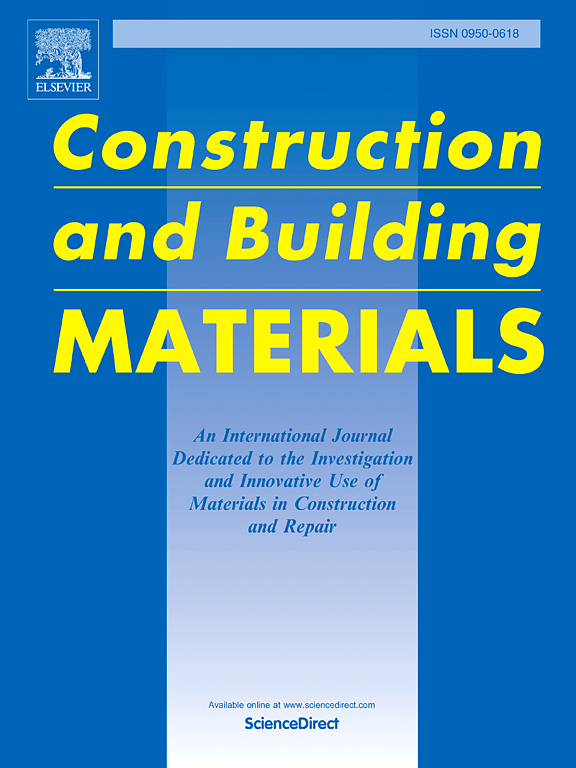rap -混凝土界面过渡区的纳米压痕和SEM分析
IF 7.4
1区 工程技术
Q1 CONSTRUCTION & BUILDING TECHNOLOGY
引用次数: 0
摘要
弱多孔界面过渡区ITZ是再生沥青路面机械强度降低、耐久性低的主要原因;从废弃沥青路面中获得的可回收材料(基于混凝土的混合物)。通过SEM-BSE、SEM-EDS和纳米压痕技术研究了水化产物、孔隙率、元素分布和弹性模量对rap -混凝土混合料ITZ特性的影响。使用两种类型的RAP聚集体-高氧化RAP(记为R1)和低氧化RAP(记为R2)。以100% %的RAP置换水平配制两种混凝土混合物,水固化至3,7和28天-将这些混合物与对照混凝土进行比较。条带描绘法SEM-BSE图像分析显示,与对照混凝土相比,rap混凝土的ITZ区孔隙率更高,水化产物较少。通过SEM-BSE, SEM-EDS(元素分布)和纳米压痕技术测定的平均ITZ厚度分别在20 - 50 µm, 22 - 50 µm和29 - 80 µm之间。体积相分布分析表明,R1混凝土样品中CH浓度较低,C-S-H密度较低,高密度C-S-H浓度较高,ITZ区孔隙率较R2混凝土样品低;从而表明前者与水泥基体的相互作用具有更高的亲和力。分析了ITZ厚度、ITZ区水化产物与抗压强度之间的关系。本文章由计算机程序翻译,如有差异,请以英文原文为准。
Nano-indentation and SEM analysis of the interfacial transition zone in RAP-concrete
Weak and porous interfacial transition zone, ITZ, largely accounts for the mechanical strength reduction and low durability in RAP (reclaimed asphalt pavement; recycled materials obtained from distressed asphalt pavements)- based concrete mixtures. A fundamental approach to elucidate the role of hydration products, porosity, elemental distribution, and elastic modulus on the ITZ characteristics of RAP-concrete mixtures was studied through SEM-BSE, SEM-EDS and Nano-Indentation techniques. Two types of RAP aggregates were utilized – high oxidized RAP (denoted as R1) and low oxidized RAP (denoted as R2). Two concrete mixtures were formulated at 100 % of RAP replacement levels and water-cured till 3, 7, and 28 days – these mixtures were compared with a control concrete. SEM-BSE image analysis by strip delineation method reveals higher porosity with lesser hydration products in the ITZ region of RAP-concrete compared to control concrete. The average ITZ thickness determined through SEM-BSE, SEM-EDS (elemental distribution), and nano-indentation techniques were found to be typically in the range of 20 – 50 µm, 22 – 50 µm, and 29 – 80 µm for control, R1, and R2 samples, respectively. From volumetric phase distribution analysis, R1 concrete sample was found to consist of lesser concentration of CH and low-density C-S-H, high concentration of high-density C-S-H, and reduced porosity in the ITZ region compared to R2 concrete samples; thereby indicating the former’s higher affinity for interaction with the cement matrix. The correlation between ITZ thickness, hydration products in the ITZ region, and the compressive strength is also elucidated.
求助全文
通过发布文献求助,成功后即可免费获取论文全文。
去求助
来源期刊

Construction and Building Materials
工程技术-材料科学:综合
CiteScore
13.80
自引率
21.60%
发文量
3632
审稿时长
82 days
期刊介绍:
Construction and Building Materials offers an international platform for sharing innovative and original research and development in the realm of construction and building materials, along with their practical applications in new projects and repair practices. The journal publishes a diverse array of pioneering research and application papers, detailing laboratory investigations and, to a limited extent, numerical analyses or reports on full-scale projects. Multi-part papers are discouraged.
Additionally, Construction and Building Materials features comprehensive case studies and insightful review articles that contribute to new insights in the field. Our focus is on papers related to construction materials, excluding those on structural engineering, geotechnics, and unbound highway layers. Covered materials and technologies encompass cement, concrete reinforcement, bricks and mortars, additives, corrosion technology, ceramics, timber, steel, polymers, glass fibers, recycled materials, bamboo, rammed earth, non-conventional building materials, bituminous materials, and applications in railway materials.
 求助内容:
求助内容: 应助结果提醒方式:
应助结果提醒方式:


